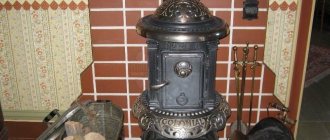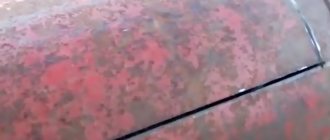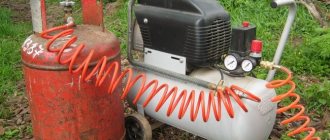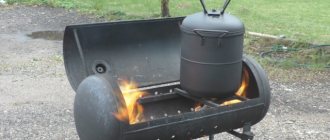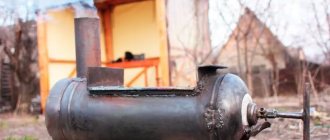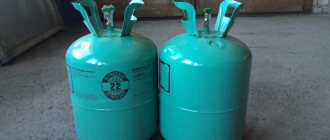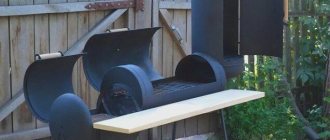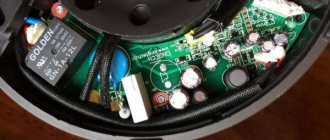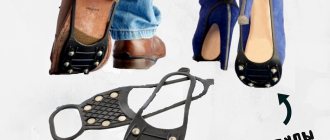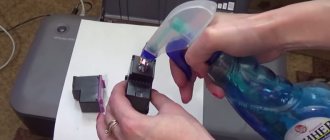How to cut a balloon safely
When making a gas cylinder from propane or other gas, fairly high quality metal is often used. That is why many are considering the possibility of cutting it to obtain blanks, which are later used to create various products. When considering how to cut a gas cylinder, it is recommended to pay attention to the following points:
- The body can be a good workpiece for making a stove, water tank or barbecue.
- Before actual work, the oxygen gas cylinder should be emptied, since the gas at its high concentration is not only flammable, but also explosive. Therefore, before cutting, you should check the filling level of the gas cylinder.
- As a rule, there are no significant problems with oxygen and carbon dioxide gas cylinders. This is due to the fact that ordinary iron is used in their manufacture.
- Propane gas tanks can cause some pretty serious problems. This is due to the fact that it is quite difficult to empty them completely; this requires preliminary preparation.
Gas cylinder explosion
Before you begin, you also need to prepare the required set of tools. As a rule, it can be found in almost any garage and workshop.
INDEPENDENT REPLACEMENT OF FITTINGS
According to the rules of safe operation, independent installation of valves on gas cylinders is strictly prohibited. If the situation is hopeless, you can very carefully try to replace the device yourself. Technically, the work itself is not difficult, but breaking the seal of the cylinder is always fraught with risk.
To begin with, it is worth considering the process of replacing the valve by a technician at a specialized enterprise. Removal of the fittings is carried out using a cylinder valve wrench. A dynamic key is used for installation. The tightening force should not exceed 250 N for brass fittings and 480 N for steel fittings. Before delivery of the gas cylinder, the threads are sealed with paint.
In handicraft conditions, you can try to remove and install the valve manually. To increase the tightness, use FUM tape.
The replacement process will look like this:
- the cylinder is completely emptied of gas away from residential premises;
- carefully unscrew the valve;
- smoothly remove the device without damaging the case;
- gas condensate is poured out;
- install a new valve;
- check the tightness of the device.
Important information for consumers! The valve on the cylinder should only be changed by specialists. There is an unspoken ban on such activities by non-professionals. However, there are times when there is simply no other option but to do the job yourself. This video shows how to unscrew the valve (valve) on a cylinder using improvised means in a country house or garage.
Source
What will you need?
To carry out the work in question, a certain set of tools is required. As a rule, cutting is carried out with a grinder. Other necessary tools are as follows:
- Gas and open-end wrench for working with the valve. In order to remove all the gas from the container, the valve must be fully opened.
- A hacksaw is also used for cutting, for example, in the case of cutting off the neck. It is worth paying attention to the correct choice of a suitable cutting blade, since too soft metal leads to rapid grinding of the teeth.
- Water is used to clean the surface. It is usually poured into a container.
When working with an angle grinder, you should be careful, since the circle is in contact with a small area. In addition, when cutting, you should use safety glasses, as a large number of fragments and burning abrasive are formed.
Cutting a gas cylinder with a grinder
For an angle grinder, it is important to choose the most suitable circle. This is because the wrong abrasive wheel can quickly wear down. Before each cutting, you should check the integrity of the nozzle and its secure fastening. Cutting without a protective cover is not allowed.
Shut-off valves for gas cylinders
A valve is a shut-off device used to fill gas cylinders, supply gas to a burner or cutter and allow storing compressed and liquefied gases in the cylinder. Valves are divided into balloon and ramp valves . The operating principle of cylinder valves is the same, but they differ in the material from which they are made, the connecting thread and the method of sealing. Valves are also divided according to the type of gas.
Oxygen valves are made of brass , since brass, unlike steel, does not burn in a compressed oxygen environment. Flywheels and plugs can be made of steel, aluminum alloys and plastics.
The design of the oxygen valve is shown in Figure 1. The valve consists of a body 9 with a fitting. An oxygen reducer is connected to a fitting with a right-hand thread using a union nut. The body contains a valve 11 with a seal 12. A union nut 6 is screwed onto the upper part of the body, tightly pressing the fiber gasket 7. A handwheel 3 is placed on the protruding part of the spindle 5, which is secured using a spring 2 and a flywheel nut 1 and is sealed with a fiber gasket 4. Valve is equipped with a plug 10. In order to open the valve for the release of oxygen from the cylinder, it is necessary to turn the handwheel 3. The valve opens by turning the handwheel counterclockwise, and closes by turning it clockwise. Rotation from spindle 5 to the valve is transmitted by connecting coupling 8. The valve has an oil seal in the form of a fiber gasket 7. To reduce friction of the spindle collar, a fiber gasket is installed after impregnation with paraffin for 40 minutes at a temperature of 70°C.
a - oxygen, b - acetylene, c - propane-butane
Figure 1 - Shut-off valves
During operation, all parts of the oxygen valve must be thoroughly degreased, since contamination with fats and oils is unacceptable.
Acetylene valves are made of steel ; the use of copper alloys containing more than 70% is unacceptable, since upon contact with acetylene, explosive acetylene copper appears.
The acetylene cylinder valve consists of a housing 10, the reducer is connected to the acetylene cylinder with a clamp equipped with a special pressure screw. To rotate spindle 5, a socket wrench is used, placed on the protruding square of the tail spindle. The lower part of the spindle has a seal 6 made of ebonite, which is a valve. Leather gaskets 3 are used as a gland, pressed by a gland nut 1 and washer 2 to the gland ring 4. A felt gasket 9 is inserted into the threaded tail of the valve, which acts as a filter. Felt filter 9 and mesh 7 are fastened with a steel ring 8. On the side face of the valve body there is an annular recess into which the fitting gasket 11, made of leather or other elastic material, is inserted. The inlet fitting of the acetylene gearbox is pressed against this gasket. The acetylene valve has a thread different from other types of valves, which excludes the possibility of installing it on other cylinders.
The valve for a propane-butane cylinder consists of a steel body 1, inside of which there is a rubber stocking nipple 3. The nipple is put on the spindle 2 and the valve 4 and clamped with a stuffing box nut 5.
How to proceed?
Once everything you need has been purchased or found, you can begin the actual work. The sequence of actions is usually as follows:
- The valve opens fully to completely release the gas. Do not forget that even a small amount of such a substance can lead to fire or explosion. In addition, all clothes can become saturated with harmful odors. You can make sure that there is no more gas left in the container by covering the valve with a soapy mixture. You can drain the remaining gasoline only after completely unscrewing the valve and removing it, which is not recommended if there is pressure.
- The next step is to unscrew the valve, after which the pins and the fixing element are removed. Removing this locking mechanism is quite difficult in some cases, but if possible, a diameter of 6 mm is formed. If you can’t unscrew the valve, you can cut it off using a regular hacksaw. You can reduce the likelihood of fire by supplying water to the cutting zone, for which it is enough to use a regular hose.
- After this, the gas tank is filled with water. This is required in order to remove any remaining gas that may remain in the semi-closed container. The resulting gasoline solution can be safely drained, as it is absolutely safe and cannot ignite.
- It is worth considering that the resulting liquid has a persistent and rather pungent odor. That is why it is recommended to drain it away from the structure. To speed up the process, you can supply compressed air to the gas container.
- After the container is completely cleaned, you can begin actual cutting. To do this, mark the surface, for which you can use chalk. Many people cut along welded seams, since they are characterized by less high strength.
- Before work, it should be taken into account that in most cases, steel with a thickness of 3-4 mm is used in the manufacture of a gas cylinder. At the joints this figure increases to 5-6 mm. Almost any grinder can cope with such a task.
- You can simplify your task by passing the grinder prematurely when using a 1.6 mm thick disc. By using a wider blade, you can eliminate the possibility of jamming the attachment that will be used for the final cutting.
- Some thicker elements may be cut, and then cut with a chisel and hammer. Due to this, the cutting process is accelerated, but the quality of the resulting cut is significantly reduced.
The cutting methods under consideration are used so that the gas cylinder can be reused in the production of a wide variety of products. If, after cutting it, a pungent odor remains, then the inner surface is burned with a blowtorch. After such processing, the body will be ready for further use.
Soldering a gas boiler heat exchanger
All water, air and solids are removed from the exchanger. Blow through a hose by machine, and blow out the residue with your mouth.
Four components are used for soldering:
- soldering tool (gas torch, blowtorch or soldering iron);
- solder;
- flux;
- tools for stripping before and after.
Solder is a material for joining workpieces that has a lower melting point than the base being processed. Solders are usually made from metals. They are produced in the form of wire, embedded parts, pastes, foil, powders, rods and granules. Wires are most suitable for soldering the heat exchanger. Take this one.
What should you pay attention to?
There are a few things to consider when cutting. The main ones can be called:
- Cutting must be carried out using special protection.
- Processing along the seams is easier, but often the markings do not match. When cutting on a round plane, you need to put a slight load on the grinder, since a small contact area leads to slipping of the nozzle.
- Many problems arise with removing rust and paint.
In general, we can say that the cutting process does not create significant problems.
Precautionary measures
During any operations with gas equipment, the user must follow the operating and maintenance rules and take all precautions for personal safety, protection of surrounding people from injury, as well as keeping the equipment in good condition.
Basic safety requirements:
- It is prohibited to use vessels with expired inspection dates and with obvious damage to the composite body or shut-off valves.
- Install the cylinder exclusively in a vertical position.
- Storing vessels with a volume of more than 5 liters in residential premises is prohibited. Minimum distances to utilities in the house: from the cooking stove - 0.5 m, from the firebox door - 2 m, from the wall - 0.30 m, from electrical wiring - 1.0 m.
- When storing vessels, they are firmly secured with clamps and protected from sunlight and heating devices. The distance to the radiator must be at least 1 m, and from open heating sources - 5 m; when placing protective screens, it is reduced to 0.5 m.
- Heating of the valve fittings is allowed after the gas has completely drained from the cylinder and the tap has been closed.
- Valve replacement begins after the pressure inside and outside the vessel has equalized.
- Unscrew the flywheel very slowly in order to prevent its electrification, sparks and explosions.
- There can only be 1 locked GB in a room.
- Residual gas may only be drained in an open area.
- It is prohibited to heat the cylinder to increase the pressure of the medium and to repair faulty vessels with gas residues. It is prohibited to leave broken gas cylinders in places where people are constantly present.
- It is necessary to periodically check the operation and tightness of the valve.
- In the event of a fire, extinguishing is carried out with fire extinguishers OU-2A, OHP-10 and stove mixture, and the Ministry of Emergency Situations is also urgently called.
- If you are poisoned by combustion products, you must go to the hospital or call an ambulance at home.
- If gas leaks are detected, the taps must be immediately turned off, the room must be ventilated, and an emergency call must be made to the Ministry of Emergency Situations.
- It is forbidden to use the entire contents of the cylinder; the residual pressure must be at least 0.5 kgf/cm2.
Important! Carrying out any repair operations with gas cylinders is potentially dangerous work. There is a strict ban on removing valves from gas vessels at home.
Examples of using cut gas cylinders
The parts of the cylinder can be used to achieve a variety of purposes. The following cases are examples:
- Furnace body.
- Containers for storing liquids.
- Grill.
- Smokehouse.
Gas cylinder stove
The scope of application is wide, but it is worth considering that the metal is not characterized by high corrosion resistance. An exception is a propane gas cylinder, which is coated with paint using a special technology.
Indications for replacement
In order to send the cylinder in time for repair work and performance testing, perform an external inspection and pay attention to the following:
- Is the shut-off valve flywheel spinning?
- on the body and valve of the cylinder, whether mechanical deformation is visible in the form of abrasions, cracks and traces of corrosion damage;
- validity of technical inspection data;
- feeling the smell of the gas-air environment next to the cylinder;
- skewed or damaged shoe at the base;
- absence of a plug on the fitting.
Before replacing the valve of a gas cylinder with your own hands, the user needs to be able to not only externally determine the malfunction of the cylinders, but also identify counterfeit products. All cylinders that are permitted for use in Russia must be produced in a certified production facility and comply with GOST requirements. This can be easily determined by examining a metal plate on which the main text is located on 2/3 of its area, and all letters must be the same height, equal to 6 mm.
Data on the cylinder:
- Permissible pressure in MPa;
- test pressure in MPa; volume in liters;
- factory number;
- date of issue “MM.YY.AA”, where M is the month, G is the year of manufacture, A is the year of the next inspection;
- empty tank weight in kg;
- mass of container with gas in kg;
- the next check is in the “R-AA” format, where “R” is the stamp of the state verifier, A is the year of validity of the certification.
To replace the valve you need a gas wrench
First stage: cut and cook
First, you will have to do metal cutting and welding - to perform these works you will need the appropriate equipment, as well as skills in handling it. So, we have stocked up with the required number of discs, a grinder and a welding machine - now we can get to work. The step-by-step process of welding 2 discs is as follows:
- Using a grinder, cut off the rim from the outside of the first wheel.
- Cut off the rim on the outside of the second wheel.
- We install the first disc on the rear axle hub and secure it.
- We put on the second part and perform alignment, eliminating runout.
- We fix the contact at four points by welding.
- We weld the seam along the entire circumference - this is necessary in order to ensure the necessary strength of the structure.
- Using a grinder, we clean the weld seam outside and inside. It should be remembered that the balancing of the wheel will depend on the quality of stripping.
Making welds
If we weld a steel strip inside, the process will look similar, but will differ in some details:
- Cut the outer rim to the inner part of the wheel.
- We cut out a steel strip of the required size and bend it around the circumference - for this it is best to use rollers. They will provide the required accuracy.
- We install the disk on the hub and fix the steel strip on it by welding.
- We weld the outer rim onto the strip so that deformation does not occur.
Preparation
At the initial stage, you need to fully understand the entire process. You should know that the starting material for manufacturing is stamped car wheels. Cast ones will not be suitable, since welding work will be carried out during the process - cast products do not withstand thermal loads.
The rim width of discs can be increased in 2 ways:
- a steel plate is welded into the middle;
- from two ordinary disks cut in half, one wide one is welded.
You should estimate what width of rims the design of your car allows. For VAZ cars, width 7j is usually chosen. But if you cut or roll out the wheel arches, you can increase the width to 10 j. So, first we need to calculate the width of the rim we want to get.
If we decide to use the method of welding two disks, we need to take this into account and stock up on the required number - for each welding we will need 2 disks.
Transportation rules
- Transportation is carried out in specially equipped vehicles marked with warning signs.
- A special permit is issued for the transportation of cylinders with LPG and technical gases.
- Each gas cylinder is designated by its own color: household propane-butane mixture – red, oxygen – blue, acetylene – white, carbon dioxide/nitrogen – black with the designation of the chemical element/compound, argon – gray, helium – brown.
- It is strictly prohibited to transport containers with different gases together, as well as empty/consumed ones together with full ones.
- When transported in a car, they are laid horizontally no higher than the sides, in no more than three rows; in a container - standing, and it is permissible to transport tanks with oxygen and acetylene together.
- Propane-butane containers can be transported standing up without containers, with a spacer between them and a reliable fence.
When loading/unloading gas cylinders, it is prohibited:
- To work alone, there must be at least two loaders.
- Work in overalls and gloves contaminated with fuels and lubricants and vegetable oils.
- Load oxygen tanks into a car body that has spills/stains of fuel and lubricants, as well as debris and foreign objects.
- It is strictly unacceptable to carry containers with gases on your arms/shoulders, roll the cylinders, or move them, dropping them, or hitting them against each other.
- Hold and feed the container with the shut-off valve down.
- Load/unload tanks without protective caps.
Inside buildings, steel containers with any gases must be transported on a stretcher with reliable fastening or a special trolley with wheels with rubber tires; In this case, it is permissible to transport two cylinders together - with oxygen and acetylene for gas welding work.
Final stage: painting
And the last stage is painting. However, before this stage, you need to check the welds for runout and roll them. Once you're sure everything is in order, you can think about painting.
Once you have chosen the appropriate enamel, apply it in the following way:
- Carefully sand the surface of the product.
- Degrease using white spirit.
- Apply a layer of primer - it will fill all the micro-irregularities and increase adhesion, ensuring better adhesion of the paint to the metal.
- After the primer has dried, apply the enamel in several layers.
- When the paint dries, it is advisable to coat it with varnish - such a coating will be more durable and aesthetically pleasing.
At home
The rules for the use of gas cylinders, as well as their manufacture and storage, are set out in several official documents:
- “Industrial safety rules for hazardous industries where equipment under excess pressure is used,” approved by Order No. 116 of March 25. 2014 Federal Service of Rostekhnadzor.
- PPR in the Russian Federation.
- GOST 15860-84, establishing technical. conditions for cylinders with liquefied hydrocarbons with pressure up to 1.6 MPa.
The recommendations of the Federal State Institution VNIIPO dated June 13, 2000 on the tactics of fire departments in conditions of the possibility of an explosion of gas-cylinder equipment at the source of a fire provide the following information:
- Cylinders for storing and transporting liquefied/compressed hydrocarbon gases (LPG) have become widespread in various areas of industry, as well as in everyday life.
- In accordance with GOST 15860, 25 enterprises in Russia produce welded steel cylinders for storing LPG.
- Their total number is about 40 million pieces.
- The main types have a capacity of 27.50 liters, which is up to 85% of the total.
Storage and use of gas cylinders
Considering that, according to GOST, the permissible service life of cylinders subject to compliance with the rules, technical inspection once every five years is 40 years, it is easy to imagine that in recent years their number has increased both in everyday life for cooking, on construction sites, in the workshops of industrial enterprises for fire , including gas welding work, has only increased; as well as the number of fires, where explosions took place, and loss of life.
Basic requirements of industrial safety standards for the use of cylinders with propane, butane, and their mixture when used in everyday life:
- It is prohibited to store LPG cylinders in private houses, apartments, stairwells, basements/attics, and on loggias/balconies of multi-story residential buildings.
- Kitchen stoves and gas units for heating water are required to have an LPG supply from tanks installed outside residential buildings in extensions/cabinets made of non-combustible material, located near blank external walls, at least 5 m from the entrances to the house, basements/basements. An exception is 1 tank up to 5 liters connected to the stove.
- Cabinets for containers with LPG must be locked, equipped with blinds for constant ventilation, and provided with the following inscriptions: “Flammable. Gas".
- At the entrances to private houses, townhouses, block sections, premises of buildings where LPG tanks are used, an inscription/plate is placed: “Flammable. Gas cylinders."
The simplest precautions are also mentioned - it is forbidden to use household appliances if there is a gas leak that has a characteristic odor; Under no circumstances should you check the tightness of any connections in the gas path from the entrance to the apartment to the devices using an open flame. At home, you can check for gas leaks with a soap solution, but it is better not to do it on your own; and shut off the supply and, depending on the situation, call representatives of the emergency gas service or service organization/enterprise
At home, you can check for gas leaks with a soap solution, but it is better not to do it on your own; and shut off the supply and, depending on the situation, call representatives of the emergency gas service or service organization/enterprise.
Rules for storing gas cylinders
Leak test
To check the tightness of shut-off valves, gas is pumped into the vessel under pressure using a compressor or two cylinders are connected with a hose - the one being tested (empty) and the other filled with gas. The test vessel is filled with gas up to 2 atm, control is carried out using a pressure gauge. Apply soap foam to the threaded connection and open the valve slightly. If soap bubbles do not appear, then there are no leaks, otherwise you need to re-tighten the valve and tighten the nuts.
The test is performed several times in a row, in the open and closed positions, using new foam. It is strictly prohibited to check the tightness with a match or lighter - due to the risk of fire and explosion of the gas-air mixture. It is important to know about the dangerous mistake that users make with left-handed gearbox threads; if, out of habit, they are tightened incorrectly, then leaks will become larger.
Malfunctions and repairs
Warranty and post-warranty repairs of a gas cylinder must be carried out by a qualified specialist.
Attempts to troubleshoot problems yourself lead to tragic consequences.
Reasons why a gas tank is found unsuitable for use during an ongoing inspection and is sent for repair:
- malfunction of the valve, pressure gauge (including cracks in the glass that prevent readings from being taken);
- damage, displacement or missing shoe;
- wear or malfunction of the thread of the neck ring;
- violation of tightness, leakage;
- for metal containers, color discrepancy or discoloration.
The gas storage tank must be disposed of and not repaired if the following deficiencies are detected:
- significant external damage: corrosion, dents, bulges, fistulas, cracks, risks, more than 10% of the container wall thickness;
- absence of passport data, markings in whole or in part (if, based on residual information, it is not possible to restore the marking);
- cracks on and around the weld more than 0.2 mm wide and more than 30% of its length.
All other containers after warranty or post-warranty repairs are suitable for further use.
Valve device
As we said above, the valve in a propane cylinder is practically no different from what is on a container containing oxygen or other gas. They all have approximately the following structure:
- A durable cylinder made of steel with three holes. Each of these holes is threaded and is intended for screwing onto the cylinder, mounting a plug and a valve nut fitted in the upper cylindrical part;
- A handwheel mounted to the valve stem via a nut;
- Locking device with a rod and a bypass valve. This valve transmits torque from the flywheel. The pressure that this part can withstand varies from 15 to 190 atmospheres;
- Gaskets designed to maximally seal the connections between all parts of the assembly.
Why do cylinders become covered with frost?
Here you can also debunk one of the most common misconceptions. It is generally accepted that if such a device “freezes,” it becomes covered with frost. Some even argue that such equipment should be insulated with blankets, old coats and other improvised items. So, the frost will disappear faster if you leave the gas container as is, without helping it “thaw” with warm things.
The bottom of a gas cylinder that is covered with frost
The appearance of frost can be explained by a number of physical processes that occur inside the structure when it is connected to stoves or burners. At such moments, active fuel consumption is observed, therefore, large volumes of gas liquid turn into a vapor fraction. And this phenomenon is always accompanied by high heat consumption, which is why the surface of the cylinder becomes much colder than the temperature in the surrounding space. Moisture in the air space begins to appear in the form of condensation on the walls of the installation, subsequently turning into frost. This is an absolutely natural phenomenon that you don’t need to do anything about.
Moreover, all attempts to use artificial “insulation” violate safety standards during operation, and also affect the deterioration of heat exchange between the device and the environment and affect the gas supply conditions. If your burner did not delight you with a grandiose flame, then after your “maneuvers” with the blanket, it may stop working altogether.
